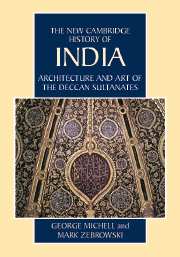Book contents
- Frontmatter
- Introduction
- 1 Historical framework
- 2 Forts and palaces
- 3 Mosques and tombs
- 4 Architectural decoration
- 5 Miniature painting: Ahmadnagar and Bijapur
- 6 Miniature painting: Golconda and other centres
- 7 Textiles, metalwork and stone objects
- 8 Temples
- 9 Conclusion
- Appendix: Dynastic Lists of Deccan Rulers
- Bibliographic Essay
- Bibliography
- Index
- Map of the Southern Deccan"
- Plate Section"
2 - Forts and palaces
Published online by Cambridge University Press: 28 March 2008
- Frontmatter
- Introduction
- 1 Historical framework
- 2 Forts and palaces
- 3 Mosques and tombs
- 4 Architectural decoration
- 5 Miniature painting: Ahmadnagar and Bijapur
- 6 Miniature painting: Golconda and other centres
- 7 Textiles, metalwork and stone objects
- 8 Temples
- 9 Conclusion
- Appendix: Dynastic Lists of Deccan Rulers
- Bibliographic Essay
- Bibliography
- Index
- Map of the Southern Deccan"
- Plate Section"
Summary
The seemingly unending cycle of raids, sieges and invasions of the period under consideration helps explain why defensive works in the Deccan were accorded such architectural importance. Fortified cities and impressive strongholds were occupied successively by different armies, thereby experiencing more than one phase of construction; some sites span many hundreds of years, even going back to pre-Sultanate times. Disentangling the chronology of the various structural additions, replacements and renovations is no easy task and further research is still much needed. Studying palace architecture in these centuries is further hampered by an overall scarcity of well-preserved examples. Ceremonial, residential and service buildings were often built in lighter materials, such as wood and plaster, rendering these structures vulnerable to damage, if not total destruction. Furthermore, parts of palace complexes that now consist of overgrown piles of rubble await archaeological exploration.
On their arrival in the Deccan, the armies of the Delhi sultans encountered a longstanding tradition of military architecture. The chiselling of the sides of the great basalt hill that forms the dramatic focus of the Devagiri citadel had already been completed at this time; so too the concentric rings of granite fortifications at Warangal. Ramparts at these and other pre-Sultanate sites, such as Raichur, have walls with quadrangular bastions constructed of long stone slabs laid without any mortar. Gateways consist of bent entrances and passageways roofed with horizontal beams. Unfortunately, there is virtually no evidence for Deccani palace architecture in pre-Sultanate times.
Keywords
- Type
- Chapter
- Information
- Architecture and Art of the Deccan Sultanates , pp. 23 - 62Publisher: Cambridge University PressPrint publication year: 1999



